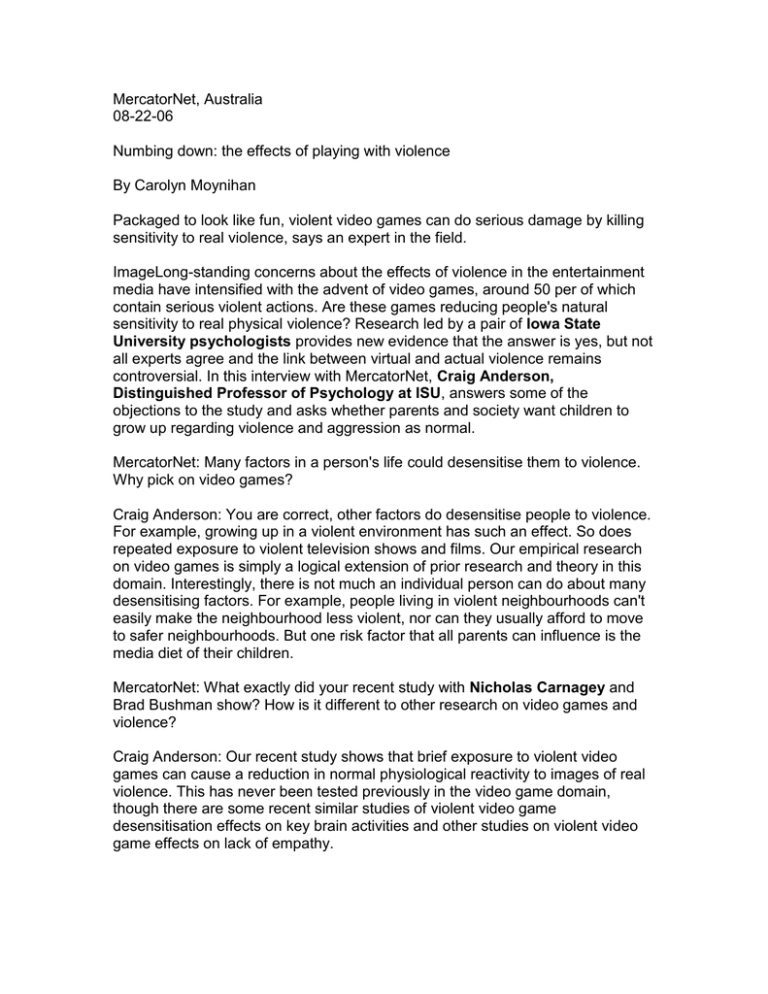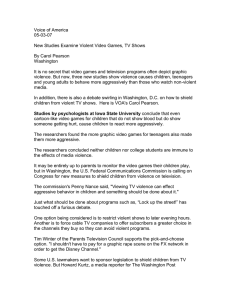MercatorNet, Australia 08-22-06 Numbing down: the effects of playing with violence
advertisement

MercatorNet, Australia 08-22-06 Numbing down: the effects of playing with violence By Carolyn Moynihan Packaged to look like fun, violent video games can do serious damage by killing sensitivity to real violence, says an expert in the field. ImageLong-standing concerns about the effects of violence in the entertainment media have intensified with the advent of video games, around 50 per of which contain serious violent actions. Are these games reducing people's natural sensitivity to real physical violence? Research led by a pair of Iowa State University psychologists provides new evidence that the answer is yes, but not all experts agree and the link between virtual and actual violence remains controversial. In this interview with MercatorNet, Craig Anderson, Distinguished Professor of Psychology at ISU, answers some of the objections to the study and asks whether parents and society want children to grow up regarding violence and aggression as normal. MercatorNet: Many factors in a person's life could desensitise them to violence. Why pick on video games? Craig Anderson: You are correct, other factors do desensitise people to violence. For example, growing up in a violent environment has such an effect. So does repeated exposure to violent television shows and films. Our empirical research on video games is simply a logical extension of prior research and theory in this domain. Interestingly, there is not much an individual person can do about many desensitising factors. For example, people living in violent neighbourhoods can't easily make the neighbourhood less violent, nor can they usually afford to move to safer neighbourhoods. But one risk factor that all parents can influence is the media diet of their children. MercatorNet: What exactly did your recent study with Nicholas Carnagey and Brad Bushman show? How is it different to other research on video games and violence? Craig Anderson: Our recent study shows that brief exposure to violent video games can cause a reduction in normal physiological reactivity to images of real violence. This has never been tested previously in the video game domain, though there are some recent similar studies of violent video game desensitisation effects on key brain activities and other studies on violent video game effects on lack of empathy. MercatorNet: You had roughly equal numbers of male and female college students in the study. Why was that, given that girls don't play video games to the same extent as boys, let alone games such as Mortal Kombat and Carmageddon? Or do they? Were there any significant differences in response? ImageCraig Anderson: First, the assumption that young women do not play violent video games is simply wrong. They don't play such games as much as do young men, but the number girls and young women who play violent games is large and growing. Second, it is good research practice to include both males and females in such studies for comparison purposes. The results found no difference in the effect of violent video games on males versus females. That is, the desensitisation effect appeared to be pretty much the same for males and females. MercatorNet: One critic (Jonathan Freedman) says your study only shows that people can be desensitised to images of violence, and proves nothing about what would happen in real life situations. Isn't it true that in real life there would be witnesses and other factors which would inhibit violent behaviour? Craig Anderson: In fact, there is research showing that decreased sensitivity to images of violence is associated with decreased helping and increased aggressive behaviour in real life situations. And, we have replicated the present physiological desensitisation study with a new study using the same video games and basic procedure, but with a measure of helping behaviour; we found a significant decrease in helping by those who had just played a violent video game. This latter study has not yet been published. MercatorNet: Another criticism of the violent media-violent behaviour link is that it may work the opposite way: that violent people gravitate to violent games. How do you respond to that? Craig Anderson: This is an old criticism that has been addressed many times in the violent television research literature and, more recently, in the violent video game research literature. In general, there is some evidence that more aggressive people tend to prefer more aggressive entertainment. But, even once scientists control for this effect, the research still shows a reliable causal effect of media violence exposure on aggressive behaviour. In other words, there does appear to be some bi-directional causality, but the evidence linking media violence to later aggression is much stronger than the other direction. And of course, this particular criticism is totally irrelevant to experimental studies of the media violence/aggressive behaviour link, studies in which participants are randomly assigned to different conditions of the study. Our recent desensitisation study was such an experiment. Therefore, both high and low aggressive individuals were included in all conditions of the experiment. Furthermore, we measured trait aggressiveness and found that it did not affect our results. MercatorNet: Boys have always gone in for rough and even violent entertainment -- cowboys and Indians, cops and robbers, war films, James Bond ... Is the level of violence today so much worse? ImageCraig Anderson: Good question. First, when children play cowboys and Indians or cops and robbers, there is very little true aggression -- the players seldom try hurt each other physically. If someone does get hurt, there are immediate consequences and some learning about social interaction takes place (for example, don't hurt other people). This type of learning about the real consequences of harming others is largely absent in violent video games. Second, part of the long-term effect of media violence on aggression is due to desensitisation to violence and images and thoughts of violence. Many violent video games, television shows, and films depict forms and graphic details of violence (such as blood, body parts) that are not a part of children's play at cops and robbers. Third, high exposure to violent television shows and movies has repeatedly been shown to yield increases in aggressive behaviour, for most of the same reasons that violent video games have this effect. So yes, the current childhood entertainment environment contains, for many children, much more exposure to violence than in the past. MercatorNet: To a thinking lay person it seems pretty logical that consuming hour after hour of mayhem and murder in films, TV programmes and games would make them more likely to behave like that. Faced with the scepticism of experts, should we trust our instincts? Craig Anderson: In fact, many lay people do not understand or believe that high exposure to media violence does increase the likelihood of future aggressive behaviour. Furthermore, the real experts on media violence effects, those who actually do basic empirical research on human aggression, agree that media violence is a significant risk factor for aggressive and violent behaviour. That is why virtually all relevant professional associations (such as the American Academy of Paediatrics, American Academy of Child & Adolescent Psychiatry, American Medical Association, American Academy of Family Physicians, American Psychiatric Association, and the American Psychological Association) have taken formal stands on this issue. MercatorNet: In reporting your study you and your colleagues used some strong language about the social significance of media violence and about the way video games in particular are marketed to attract children... Craig Anderson: First, let's be clear about what we have said, and haven't said. We have never called for or advocated a governmental ban on the production or sale of violent video games. That is a public policy issue, not a scientific one, though of course the scientific facts are relevant to some aspects of a good public policy debate and decision process. In fact, despite what one sometimes sees in various blogs, discussion groups, and attacks on media violence research, I have never said what my personal views are on the issue of how best to address the issue. The closest I've come to advocating a public policy is to note that educating parents about the true effects of repeated exposure to media violence is important, and that providing parents with better tools to make their parenting tasks easier would probably be useful as well. Second, anyone who knows the research and practice of systematic desensitisation as a therapeutic tool also can see interesting similarities between the therapeutic tool and the way we socialize children to accept violence in the entertainment media. In therapy, systematic desensitisation is used to help people overcome fears and extreme negative emotional reactions to specific situations and objects, fears and emotional reactions that seriously interfere with their jobs or everyday life. For example, one can use systematic desensitization to treat fear of snakes, spiders, and flying. There are interesting differences as well, of course, but the similarities are somewhat troubling in their implications. ImageBasically, we introduce young children to very playful, fun, cartoonish forms of violence, with little or no blood, no real consequences to the victim or friends and family of the victim. It is done with happy music, cute characters, and in a fun and non-threatening way. With increasing age, we gradually add more realistic and more threatening elements, but still often in a humorous context. Eventually, we end up with a lot of (certainly not all) adolescents, young adults, and older adults who are accustomed to and comfortable with seeing lots of blood and gore, with an exaggerated view of much violence exists or is "normal" in modern society, and with belief systems that are supportive of use of aggression or violence in various domains of life-personal as well as societal. Present rating systems of films, television, and video games play a major role in supporting this societal-level desensitisation process, though of course such a process existed to some extent prior to the creation of the rating systems. Now a key question that has never really been debated publicly is whether or not we as a society or as individual parents want to socialize our children in this systematic way. Some will certainly answer "no"; others will answer "yes"; and lot of people will not have an opinion. I think the question needs to be asked, but all need to understand that the answer to this question is a public policy "values" type question, not one that has a scientifically correct "yes" or "no" answer. A second key question concerns what public policies best meet the values of the various people who have various answers to the first key question. My colleagues and I have written about various potential policy options, and have several new articles and a book coming out that outlines some options that others have proposed and that other countries use. But again, we do not take strong stands on which options "should" be adopted, except that some of us occasionally advocate for better education of the general public about what the relevant research shows and what it doesn't show. MercatorNet: There is, of course, a cheap and simple way -- not requiring too much more research! -- to bring the influence on children under control. It's called parents. What in your view can and should parents do to limit their children's exposure to media violence and stop them developing a taste for it? Craig Anderson: Many parents already do a pretty good job of monitoring their children's media diet and screening out potentially harmful materials. Many do not do so at all. I know of parents who play Grand Theft Auto with their 6-year old. Existing rating systems certainly can aid parents in these monitoring and screening tasks. But parents also must realize that existing rating systems have weaknesses. One of the weaknesses is that the systems seem more sensitive to issues that have less scientific evidence of potential harm (e.g., bad language, consensual, safe sex in a loving relationship) than to issues that have overwhelming evidence of long-term harm (e.g., violence). Last night my 16-yearold daughter and I watched a movie that was rated R; it had considerable use of the "F" word and its various versions, but almost no violence. We were both surprised when we learned that it was R-rated. Last week I wouldn't let her watch a PG13 movie that had almost no swearing in it but was filled with violence, some of it very graphic. My point is that parents need to go beyond the age ratings and consider the content and its potential effects on their children's development. Furthermore, there is some evidence (in my research and others') that parents can reduce the negative impact of media violence by discussing issues of violence, both in the media and in the real world, with their children. Teaching children and adolescents to think of non-aggressive and non-violent solutions to various types of conflict, letting them know your values concerning the inappropriate use of aggression and violence, seems to help. It seems obvious to some people, yet many never have such discussions with their children. Carolyn Moynihan is Deputy Editor of MercatorNet.




